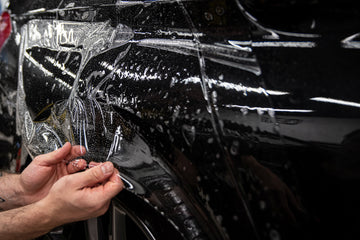
Paint Protection Film (PPF) has gained widespread popularity in recent years, but with that rising demand has come a flood of misinformation. Many consumers have unrealistic expectations about what PPF can and cannot do, leading to frustration, poor installation decisions, or wasted money. The internet is filled with exaggerated claims, some painting PPF as an indestructible force field, while others dismiss it as an overpriced gimmick.
The truth lies somewhere in between. When applied correctly and maintained properly, PPF is one of the most effective ways to protect a vehicle's paint, reducing damage from road debris, scratches, and environmental factors. However, to make an informed decision about whether PPF is right for you, it is essential to separate fact from fiction.
In this article, we will break down the most common myths about PPF and provide the facts you need to make a well-informed decision, whether you are a car enthusiast, an everyday driver, or a detailing professional.
Myth 1: PPF is Bulletproof
The Myth
Many people believe that PPF is some kind of invincible armor, capable of stopping any impact, including hail, massive road debris, or even bullets. This misconception is fueled by misleading advertisements or exaggerated YouTube demonstrations where vehicles covered in PPF are subjected to extreme abuse.
The Truth
While PPF is highly impact-resistant, it is not indestructible. It is designed to absorb minor impacts from road debris, prevent rock chips, and protect against scratches, but it will not stop severe damage from large rocks or high-speed impacts. If a rock is big enough, it can still dent the panel beneath the film, and in cases of extreme impact, even the best PPF will not prevent damage.
PPF is a protective barrier, but it is not meant to replace structural protection or body armor. Understanding its limitations ensures realistic expectations and satisfaction with the product.
What PPF Does Well:
-
Absorbs small rock chips and minor abrasions
-
Self-heals minor scratches
-
Protects against road grime, UV damage, and oxidation
If you need true bulletproof protection, armored vehicle glass and body plating are your only options.
Myth 2: PPF Will Last Forever
The Myth
Some shops and manufacturers claim that PPF lasts a lifetime, making it a one-time investment that never needs replacement. This gives car owners the false belief that once PPF is installed, they will never have to worry about their paint again.
The Truth
Quality PPF can last seven to ten years with proper care, but it does degrade over time. Environmental exposure, UV rays, and harsh weather conditions can wear down even the best films. Cheap or improperly installed films can yellow, peel, or crack in just a few years.
Even high-end PPF brands will require replacement eventually. As the film ages, its protective properties weaken, and replacing it is the best way to maintain optimal protection. Regular inspections and maintenance will help extend the life of PPF, but expecting it to last forever is unrealistic.
Factors That Affect PPF Longevity:
-
Quality of the film – Premium brands last longer than budget options
-
Climate – Hot, sunny climates can accelerate aging
-
Maintenance – Proper washing and care extend PPF life
Replacing PPF every seven to ten years is a realistic expectation.
Myth 3: PPF Will Hide Scratches and Paint Imperfections
The Myth
Many believe that applying PPF will make scratches, swirl marks, or faded paint disappear. Some even assume that PPF works like an auto body shop fix, making an old car look brand new again.
The Truth
PPF is not a fix for bad paint. In fact, it can magnify existing imperfections if the surface is not properly prepped before application. Any chips, swirl marks, or oxidation underneath the film will still be visible and, in some cases, may even appear more pronounced.
A professional installer will always recommend paint correction before PPF to ensure the best results. A properly prepared surface ensures a flawless finish and maximizes the benefits of PPF.
PPF protects your current paint condition but does not improve it.
Myth 4: Once You Apply PPF, You Never Have to Wash Your Car Again
The Myth
A common misconception is that PPF makes a car completely maintenance-free. Some car owners assume that once PPF is applied, their vehicle will remain spotless indefinitely, with no need for washing or detailing.
The Truth
While PPF reduces the risk of damage, it does not make your car immune to dirt, dust, and grime. Road debris, pollution, and environmental contaminants will still accumulate on the surface. If the car is not cleaned regularly, these contaminants can degrade the film over time.
Recommended Maintenance:
-
Use pH-neutral car soap
-
Avoid harsh chemicals or abrasive tools
-
Regularly apply PPF-safe sealants for added longevity
Regular washing and proper maintenance are key to keeping PPF looking and performing its best.
Myth 5: All PPF is the Same
The Myth
Some consumers believe that all PPF brands are equal and that price does not matter. They assume that any PPF will perform the same, regardless of manufacturer or installation quality.
The Truth
PPF quality varies greatly between brands. Cheaper PPF may yellow faster, lack self-healing properties, or peel prematurely. High-quality PPF from trusted brands offers:
-
Better optical clarity
-
Stronger self-healing properties
-
Superior resistance to yellowing and staining
-
Longer warranty and durability
Always research the brand and choose a reputable installer to get the best results.
Making the Right Choice for Your Vehicle
PPF is one of the best ways to protect your vehicle’s paint, but understanding what it can and cannot do is essential.
The main takeaways are:
-
PPF is not indestructible but offers strong protection against everyday damage.
-
It will not last forever, but high-quality film can serve you well for seven to ten years.
-
It does not fix scratches or bad paint; proper preparation is key.
-
Regular maintenance is still necessary to keep it looking its best.
-
Not all PPF is created equal; choose quality film and a skilled installer.
-
Dealership PPF installations are often lower quality than specialized shops.
Investing in high-quality PPF and a professional install ensures you get the best possible protection for your vehicle. If you are considering PPF, take the time to research your options and choose a film and installer that match your expectations.
